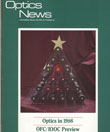
December, 1986 Issue
- Tunneling and photoconductivity
- Improved calibration standards in laser-Stark spectroscopy
- Origin of room-temperature optical nonlinearities in GaAs
- A new class of materials for nonlinear optics and nonlinear optical devices
- Binary optics: An emerging diffractive optics technology
- Squeezed states of light I
- Squeezed states of light II
- Laser cooling and trapping of atoms
- Focused-ion-beam micromachining of optical surfaces
- Photon localization
- Browse all Issues
Feature Articles
Tunneling and photoconductivity
Recently a striking new type of photoconductivity based on quantum mechanical tunneling in superlat¬tices has been reported by Capasso et al. The underlying physical cause of this phenomenon is effective mass filtering. Since the tunneling probability of carriers through the barrier layers of a superlattice increases exponentially with decreasing effective mass, electrons are transported through a superlattice much more easily than through the heavy holes. When light is shined on the superlattice, the photogenerated holes essentially remain localized in the wells while the electrons can tunnel through the barriers. Thus the superlattice acts as a filter for effective masses.
by Federico CapassoImproved calibration standards in laser-Stark spectroscopy
Two recent developments promise major improvements in both the electric field strength calibration and laser frequency standardization of Stark-tuned Lamb-dip spectroscopy, a technique developed over 15 years ago which has become a widely used tool for high-resolution studies of molecular vibration-rotation spectra.
by W. H. WeberOrigin of room-temperature optical nonlinearities in GaAs
Laser-excited semiconductors have been demonstrated to exhibit optical nonlinearities which can...
by S. W. Koch, Y. H. Lee, H. M. Gibbs and N. PeyghambarianA new class of materials for nonlinear optics and nonlinear optical devices
A new class of materials, glasses doped with micro-crystallites of semiconductors CdSxSe1-x, with crystalline sizes ranging from 50 Å to 1000 Å, has been emerging with great promise for application in nonlinear signal processing and nonlinear optical devices. Their rapid response time of a few tens of picoseconds, combined with room-temperature operation and low materials cost, make them exceptionally attractive for nonlinear device applications.
by N. PeyghambarianBinary optics: An emerging diffractive optics technology
The ultimate promises of emerging binary optics technology include sheet optics by the square meter, high-quality throwaway optical sensors, and arrays of hundreds of small modular lasers coherently added to form powerful laser beams. Binary optics refers to the two-level (high-low) nature of the phase-relief pattern used to control the phase, amplitude, and polarization of an optical wavefront.
by W. VeldkampSqueezed states of light I
AT&T Bell Laboratories recently demonstrated squeezed light using nondegenerate four-wave mixing in a sodium atomic beam to parametrically amplify and deamplify the noise fluctuations in the modes of an optical cavity. Squeezed light exiting the cavity through a partially transmitting mirror is detected by a balanced homodyne detector, which measures the squeezed field split off from the pump light.
by R. E. Slusher, L. W. Hollberg, B. Yurke, J. C. Mertz, and J. F. ValleySqueezed states of light II
IBM Almaden Research Center showed for the first time that squeezing in an optical fiber is possible over a broad range of frequencies. This broad bandwidth squeezing is important for the phenomenon to be useful in improving the precision of fine measurement devices such as gyroscopes and gravity wave detectors.
by R. M. Shelby, M. D. Levenson, S. H. Perlmutter, and R. G. DeVoeLaser cooling and trapping of atoms
During 1986, Chu et al. demonstrated the optical trapping of atoms for the first time. Optical potential wells for atoms are very shallow and can confine only extremely cold atoms.
by J. Bjorkholm, S. Chu, A. Cable, and A. AshkinFocused-ion-beam micromachining of optical surfaces
During the past few years, there has been considerable interest in monolithic integration of optical and electronic elements on semiconductor wafers to enable fabrication of optical computers and the next generation of broadband communication systems. The successful implementation of integrated optoelectronics demands the ability to form optical-quality microsurfaces to serve as mirrors or coupling elements.
by R. A. Elliot, J. Puretz, R. K. DeFreez, J. Orloff, and L. W. SwansonPhoton localization
Photon propagation in disordered dielectrics and electron localization in disordered conductors have been shown to be governed by the same physical phenomenon, coherent backscattering. The most recent developments in electron localization have focused on so-called "universal fluctuations" of the resistance of small devices. Lee et al. have pointed out that due to the buildup of correlation through multiple scattering, the conductance of a microscopic sample will fluctuate independently of its size and degree of disorder.
by S. James Allen

![A multiplexed image of a human tonsil acquired. [NIAID] using the iterative bleaching extends multiplexity (IBEX) method.](https://opnmedia.blob.core.windows.net/$web/opn/media/images/articles/2024/0424/departments/202404-cover-web.jpg?ext=.jpg)
